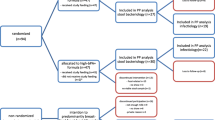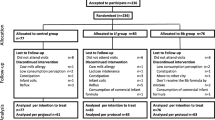Abstract
Faecal specimens from 23 infants during the first week of life were compared. Ten infants received breast milk, six received cow-milk preparation supplemented with iron (± 5 mg/l) and seven unfortified cow-milk preparation (iron concentration < 0.5 mg/l). Those on breast milk had low faecal pH, high counts of bifidobacteria and low counts ofEnterobacteriaceae, bacteroides and clostridia. Infants receiving fortified cow-milk preparation had a high faecal pH and high counts ofEnterobacteriaceae and putrefactive bacteria such as bacteroides and clostridia. Counts of bifidobacteria were also high. In those on unfortified cow-milk preparation a slow rise was observed in counts ofEnterobacteriaceae followed by an increase in counts and isolation frequency of bifidobacteria: the latter was still rising on day 7. It is concluded that a low iron content in standard preparations of cow's milk enhances resistance of the neonatal gut to colonization.
Similar content being viewed by others
References
Mata, L. J., Urrutia, J. J.: Intestinal colonization of breast-fed children in a rural area of low socio-economic level. Annals of the New York Academy of Science 1971, 176: 93.
Rotimi, V. O., Duerden, B. I.: The development of the bacterial flora in normal neonates. Journal of Medical Microbiology 1981, 14: 51–62.
Ross, C. A. C., Dawes, E. A.: Resistance of the breast fed infant to gastro-enteritis. Lancet 1954, i: 994–998.
Bullen, C. L., Willis, A. T.: Resistance of the breast-fed infant to gastroenteritis. British Medical Journal 1971, iii: 338–343.
Bullen, C. L., Tearle, P. V., Willis, A. T.: Bifidobacteria in the intestinal tract of infants: an in-vivo study. Journal of Medical Microbiology 1976, 9: 325–333.
Bullen, C. L., Tearle, P. V.: Bifidobacteria in the intestinal tract of infants: an in-vitro study. Journal of Medical Microbiology 1976, 9: 335–344.
Willis, A. T., Bullen, C. L., Williams, K., Fagg, C. C., Bourne, A., Vignon, M.: Breast milk substitute: a bacteriological study. British Medical Journal 1973, iv: 67–72.
Bullen, J. J., Rogers, H. J., Leigh, L.: Iron-binding proteins in milk and resistance toEscherichia coli infection in infants. British Medical Journal 1972, i: 69–75.
Bullen, C. L., Tearle, P. V., Stewart, M. G.: The effect of “humanised” milks and supplemented breast feeding on the faecal flora of infants. Journal of Medical Microbiology 1977, 10: 403–413.
Neilands, J. B.: Iron and its role in microbial physiology. In: Neilands, J. B. (ed.): Microbial iron metabolism. Academic Press, New York, 1974, p. 3–34.
Bullen, J. J., Rogers, H. J., Griffiths, E.: Role of iron in bacterial infection. Current Topics in Microbiology and Immunology 1978, 80: 1–35.
Weinberg, E. D.: Iron and infection. Microbiological Reviews 1978, 42: 45–66.
Van der Wiel-Korstanje, J. A. A., Winkler, K. C.: Medium for differential count of the anaerobic flora in human faeces. Applied Microbiology 1970, 20: 168–169.
Miles, A. A., Misra, S. S., Irwin, J. O.: The estimation of bactericidal power of the blood. Journal of Hygiene 1938, 38: 732–750.
Albert, M. J., Bhat, P., Maiya, P. P., Pereira, S. M., Baker, S. J.: Faecal flora of south Indian infants and young children in health and with acute gastroenteritis. Journal of Medical Microbiology 1978, 11: 137–143.
Van der Wiel-Korstanje, J. A. A., Winkler, K. C.: The faecal flora in ulcerative colitis. Applied Microbiology 1975, 8: 491–501.
De Vos, N., Mevissen-Verhage, E., Harmsen-van Amerongen, W., Marcelis, J.: A new selective medium for the culture of clostridia from human faeces. European Journal of Clinical Microbiology 1982, 1: 267–271.
Cowan, S. T. (ed.): Manual for the identification of medical bacteria. Cambridge University Press, Cambridge, 1974.
Lindner, J. G. E. M., Marcelis, J. H.: Quantitative gaschromatography of Bacteroides species under different growth conditions. Antonie van Leeuwenhoek 1978, 44: 1–14.
Holdeman, L. V., Cato, E. P., Moore, W. E. C. (ed.): Anaerobe laboratory manual. Virginia Polytechnic Institute, Blackburg/VA, 1977.
Rogers, H. J., Synge, C.: Bacteriostatic effect of human milk onEscherichia coli: the role of IgA. Immunology 1978, 34: 19–28.
Haenel, H.: Some rules in the ecology of the intestinal microflora of man. Journal of Applied Bacteriology 1961, 24: 242–251.
Rogers, H. J.: Iron-binding catechols and virulence inEscherichia coli. Infection and Immunity 1973, 7: 445–456.
Author information
Authors and Affiliations
Rights and permissions
About this article
Cite this article
Mevissen-Verhage, E.A.E., Marcelis, J.H., Harmsen-van Amerongen, W.C.M. et al. Effect of iron on neonatal gut flora during the first week of life. Eur. J, Clin. Microbiol. 4, 14–18 (1985). https://doi.org/10.1007/BF02148653
Issue Date:
DOI: https://doi.org/10.1007/BF02148653




